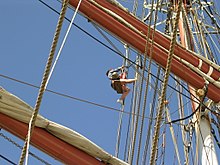
The bowline is an ancient and simple knot used to form a fixed loop at the end of a rope. It has the virtues of being both easy to tie and untie; most notably, it is easy to untie after being subjected to a load. The bowline is sometimes referred to as king of the knots because of its importance. Along with the sheet bend and the clove hitch, the bowline is often considered one of the most essential knots.

The figure-eight knot or figure-of-eight knot is a type of stopper knot. It is very important in both sailing and rock climbing as a method of stopping ropes from running out of retaining devices. Like the overhand knot, which will jam under strain, often requiring the rope to be cut, the figure-eight will also jam, but is usually more easily undone than the overhand knot.
The figure-eight or figure-of-eight knot is also called the Flemish knot. The name figure-of-eight knot appears in Lever's Sheet Anchor; or, a Key to Rigging. The word "of" is nowadays usually omitted. The knot is the sailor's common single-strand stopper knot and is tied in the ends of tackle falls and running rigging, unless the latter is fitted with monkey's tails. It is used about ship wherever a temporary stopper knot is required. The figure-eight is much easier to untie than the overhand, it does not have the same tendency to jam and so injure the fiber, and is larger, stronger, and equally secure.

A climbing harness is a device which allows a climber access to the safety of a rope. It is used in rock and ice climbing, abseiling, and lowering; this is in contrast to other activities requiring ropes for access or safety such as industrial rope work, construction, and rescue and recovery, which use safety harnesses instead.

A mooring is any permanent structure to which a seaborne vessel may be secured. Examples include quays, wharfs, jetties, piers, anchor buoys, and mooring buoys. A ship is secured to a mooring to forestall free movement of the ship on the water. An anchor mooring fixes a vessel's position relative to a point on the bottom of a waterway without connecting the vessel to shore. As a verb, mooring refers to the act of attaching a vessel to a mooring.

Glossary of climbing terms relates to rock climbing, mountaineering, and to ice climbing.

Abseiling, also known as rappelling, is the controlled descent of a steep slope, such as a rock face, by moving down a rope. When abseiling, the person descending controls their own movement down the rope, in contrast to lowering off, in which the rope attached to the person descending is paid out by their belayer.
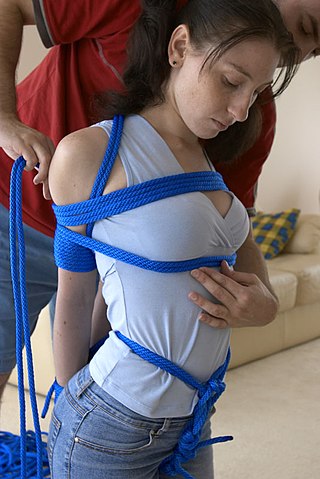
Bondage in BDSM is the activity of tying or restraining people using equipment such as chains, cuffs, or collars for mutual erotic pleasure. According to the Kinsey Institute, 12% of females and 22% of males respond erotically to BDSM.

Belaying is a variety of techniques climbers use to create friction within a climbing system, particularly on a climbing rope, so that a falling climber does not fall very far. A climbing partner typically applies tension at the other end of the rope whenever the climber is not moving, and removes the tension from the rope whenever the climber needs more rope to continue climbing.
This glossary of nautical terms is an alphabetical listing of terms and expressions connected with ships, shipping, seamanship and navigation on water. Some remain current, while many date from the 17th to 19th centuries. The word nautical derives from the Latin nauticus, from Greek nautikos, from nautēs: "sailor", from naus: "ship".
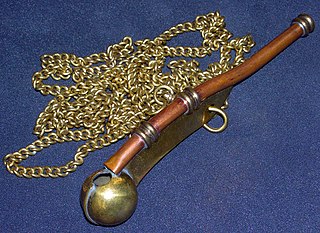
A boatswain's call, pipe, or bosun's whistle is a pipe or a non-diaphragm type whistle used on naval ships by a boatswain.

The offset overhand bend is a knot used to join two ropes together end-to-end. It is formed by holding two rope ends next to each other and tying an overhand knot in them as if they were a single line. Due to its common use in several fields, this bend has become known by many names, such as thumb knot, openhand knot, one-sided overhand knot or flat overhand bend (FOB), though the terms "one-sided" and "flat" are considered incorrect.

The bowline on a bight is a knot which makes a pair of fixed-size loops in the middle of a rope. Its advantage is that it is reasonably easy to untie after being exposed to load. It is one of the two tie-in knots that are being taught by the German Alpine Club (DAV), generally being considered secure.

A ropes course is a challenging outdoor personal development and team building activity which usually consists of high elements, low elements, or some combination of the two. Low elements take place on the ground or above the ground. High elements are usually constructed in trees or made of utility poles and require a belay for safety.

A Prusik is a friction hitch or knot used to attach a loop of cord around a rope, applied in climbing, canyoneering, mountaineering, caving, rope rescue, ziplining, and by arborists. The term Prusik is a name for both the loops of cord used to tie the hitch and the hitch itself, and the verb is "to prusik". More casually, the term is used for any friction hitch or device that can grab a rope. Due to the pronunciation, the word is often misspelled Prussik, Prussick, or Prussic.
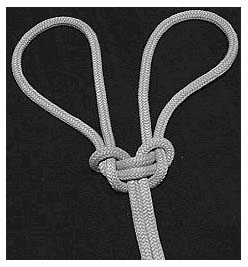
The Spanish bowline is a double loop knot that can be used to lift a person. For a conscious person, each loop is placed around a leg and the person holds onto the standing part of the rope. This knot can serve as a makeshift Bosun's chair. For an unconscious person one loop is placed around the arm pits and the second loop is placed around the knees.

A breeches buoy is a rope-based rescue device used to extract people from wrecked vessels, or to transfer people from one place to another in situations of danger. The device resembles a round emergency personal flotation device with a leg harness attached. It is similar to a zip line. The breeches buoy may be deployed from shore to ship, ship to ship, or ship to shore using a Manby mortar, rocket, kite system, or a Lyle gun, and allows evacuation of one person at a time. A line is attached to the ship, and the person being rescued is pulled to shore in the breeches buoy.

A belay device is a mechanical piece of climbing equipment used to control a rope during belaying. It is designed to improve belay safety for the climber by allowing the belayer to manage their duties with minimal physical effort. With the right belay device, a small, weak climber can easily arrest the fall of a much heavier partner. Belay devices act as a friction brake, so that when a climber falls with any slack in the rope, the fall is brought to a stop.

A Lyle gun was a line thrower powered by a short-barrelled cannon. It was invented by Captain David A. Lyle, US Army, a graduate of West Point and the Massachusetts Institute of Technology, and was used from the late 19th century to 1952, when it was replaced by rockets for throwing lines.
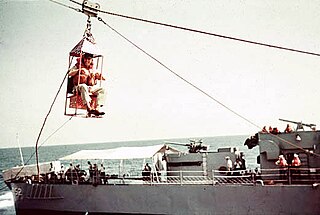
A jackstay is a cable or bar between two points to support and guide a load between those points, or as an anchor to attach something to be constrained along that line. The term is mostly used in a marine context and originated on sailing ships. Note the use of "stay" implies load bearing working rigging. In diving it is also a line to guide the movements of a diver between the endpoints.

